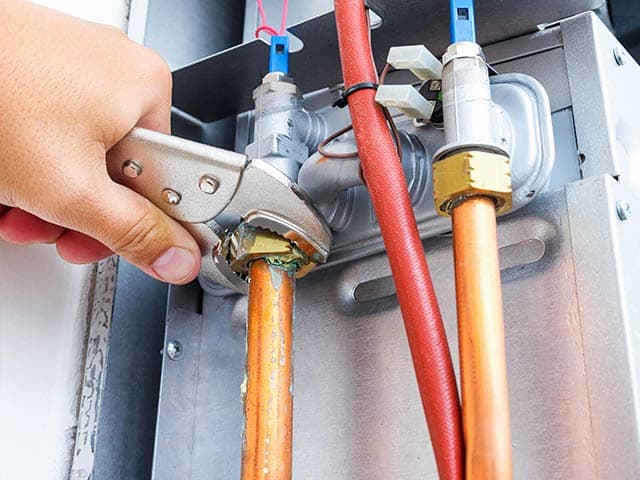Emergency Plumbing Tips and Ideas

A burst pipe can quickly turn into a homeowner’s nightmare, causing extensive damage, skyrocketing water bills, and a big mess to clean up. Whether it’s due to freezing temperatures, aging pipes, or high water pressure, knowing what to do when your pipes burst can save you a lot of time, money, and stress. In this guide, we’ll cover the essential steps you need to take when facing a burst pipe, as well as some preventive measures to help you avoid this plumbing disaster in the first place.
1. Shut Off the Water Supply
The first and most crucial step when you discover a burst pipe is to shut off the water supply immediately. Locate your main water shut-off valve, which is usually found in the basement, crawl space, or near the water meter. Turning off the water supply will stop the flow of water and prevent further flooding and damage to your home. If you’re unsure where the shut-off valve is, now is the time to find it—before an emergency occurs.
2. Turn Off the Electricity
If the burst pipe is located near electrical outlets, appliances, or your electrical panel, turn off the electricity to those areas to avoid the risk of electrocution. Water and electricity are a dangerous combination, and it’s better to err on the side of caution. Locate your electrical panel and shut off the power to the affected areas, or if you’re uncertain, turn off the main breaker for the whole house until you can safely assess the situation.
3. Drain the Remaining Water
Even after the water supply is turned off, there will still be water in the pipes. Open all your faucets to drain the remaining water and relieve pressure in the system. Start with the cold taps first, then move to the hot taps, and finally flush your toilets. This will help minimize the amount of water that escapes from the burst pipe and reduce the risk of further damage.
4. Locate the Burst Pipe
Once you’ve shut off the water and drained the system, it’s time to locate the burst pipe. Sometimes, the burst is obvious with visible flooding or a noticeable spray of water. Other times, it might be hidden behind walls, ceilings, or floors. Look for signs such as damp spots, water stains, or unusual sounds like hissing or gurgling. If you can’t find the source, a professional plumber will be able to use specialized tools to locate it. Visit their page where you will find lots of great information and practical advice about choosing the best plumber repair service.
5. Temporarily Stop the Leak
If the burst pipe is easily accessible, you can use a temporary fix to stop or slow the leak until a professional plumber arrives. Here are a few quick fixes:
- Pipe clamps or rubber patches: These can be wrapped around the burst section of the pipe to contain the leak temporarily.
- Pipe repair tape: This waterproof tape can seal small cracks or pinhole leaks.
- Epoxy putty: This malleable substance can be molded around the burst area to plug the leak.
These temporary solutions are not permanent fixes, but they can buy you some time and prevent further water damage while you wait for professional help.

6. Call a Professional Plumber
After taking the initial emergency steps, call a professional plumber to assess and repair the damage. A licensed plumber will be able to properly fix the burst pipe, inspect your plumbing system for any other potential issues, and provide recommendations to prevent future problems. It’s important not to delay this step, as a burst pipe can lead to extensive damage if not addressed promptly.
7. Begin the Cleanup Process
Once the burst pipe has been addressed, it’s time to start the cleanup process. Depending on the extent of the flooding, you might need to remove standing water using a wet/dry vacuum or mop. If the water has soaked into carpets, walls, or furniture, it’s crucial to dry these areas as quickly as possible to prevent mold growth and further damage. Dehumidifiers, fans, and ventilation can help speed up the drying process.
8. Assess and Document the Damage
Documenting the damage is an important step, especially if you plan to file an insurance claim. Take photos and videos of the affected areas, including any damage to floors, walls, ceilings, and personal belongings. Make a detailed list of what was damaged and keep any receipts for repairs or replacements. Contact your insurance provider as soon as possible to report the incident and start the claims process.
9. Prevent Future Pipe Bursts
After dealing with the immediate crisis, take steps to prevent future pipe bursts. Here are some preventive measures:
- Insulate your pipes: Use foam pipe insulation, especially in unheated areas like basements, attics, and crawl spaces. This is particularly important in colder climates where freezing temperatures can cause pipes to burst.
- Seal cracks and openings: Check for drafts and seal any cracks or openings around doors, windows, and walls near pipes to keep the cold out.
- Keep your home warm: Maintain a consistent temperature in your home, especially during the winter. Set your thermostat to at least 55°F (13°C), even when you’re away.
- Allow faucets to drip: During extremely cold weather, allow a trickle of water to run through faucets connected to exposed pipes. Moving water is less likely to freeze.
- Regularly inspect your plumbing: Schedule regular inspections with a plumber to check for signs of wear, corrosion, or potential weak points in your plumbing system.
10. Stay Prepared for Emergencies
Finally, being prepared for plumbing emergencies can make all the difference. Keep a list of emergency contacts, including a trusted plumber, electrician, and insurance provider. Familiarize yourself with the locations of shut-off valves for water, gas, and electricity in your home. Having a basic emergency kit with tools, pipe repair materials, and protective gear can also be helpful in managing minor plumbing issues.
Conclusion
A burst pipe can be a stressful and overwhelming experience, but knowing what to do in the moment can significantly reduce the damage and help you get back to normal more quickly. By acting quickly, shutting off the water, and calling a professional, you can mitigate the immediate effects of a burst pipe. Taking preventive measures and staying prepared will help you avoid future plumbing emergencies and protect your home from costly water damage. Remember, when it comes to plumbing, an ounce of prevention is worth a pound of cure!

